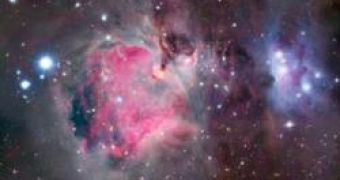The worst place where a star could grow is in the vicinity of a supermassive black hole, as powerful gravitational fields exerted by the latter prevent the clouds of gas to condense into objects such as our Sun. However, astronomers have recently discovered that young stars do form near the center of our galaxy, inside a ring-shaped cloud of gas thought to surround the Milky Way's black hole, Sagittarius A*.
This region of space, stretching from 6 to 20 light years away from the galactic center, is virtually filled with massive clouds of gas and dust that make any optical observations close to impossible. Thus, in order to look inside them astronomers resorted to making observations in the radio wavelengths of the electromagnetic spectrum. By doing so, the research team discovered natural maser sources.
A maser is basically an artificial laser operating in the microwave wavelengths. But similar laser emissions can also occur naturally in collapsing gas clouds, as frequent molecular collisions determine the cloud to emit high energy radio waves. As a result, the detection of maser signatures indicates that inside the giant gas cloud protostars are forming and they will eventually evolve into short-lived massive stars.
Although it was known for some time that the ring-shaped gas cloud had the right density to allow star formation, nobody was quite sure if the gravitational forces exerted by the supermassive black hole in the center of the galaxy are stronger or weaker than those produced by the cloud itself. "Star formation is something we don't really understand, even if it's not near a black hole," said Farhad Yusuf-Zadeh of the Northwestern University in Evanston, Illinois.
During the protostar stage, the newly formed object pulls large amounts of gas and dust in order to grow. However, not all of this material is kept, part of it being ejected back into space through high-speed jets originating from the star's poles. The observation of the effects produced by the rapid motion of these jets adds up as more evidence to Yusuf-Zadeh's new discovery. The fact that the jets are still observed today suggests that the ring-shaped gas cloud was pulled into orbit only recently.
The results of the study carried out by Yusuf-Zadeh's team could have significant relevance for the presence of stars as close as only 2 light-years away from the center supermassive black hole, since explanations to their being there often suggest that the stars actually formed father away from the center and were later placed into orbit by the violent gravitational field of the central object.
"Before this, there was basically no evidence of star formation within the molecular gas," says astronomer Nick Scoville of the California Institute of Technology in Pasadena, relating to the fact that previous investigations revealed no star formation processes at all.

 14 DAY TRIAL //
14 DAY TRIAL //